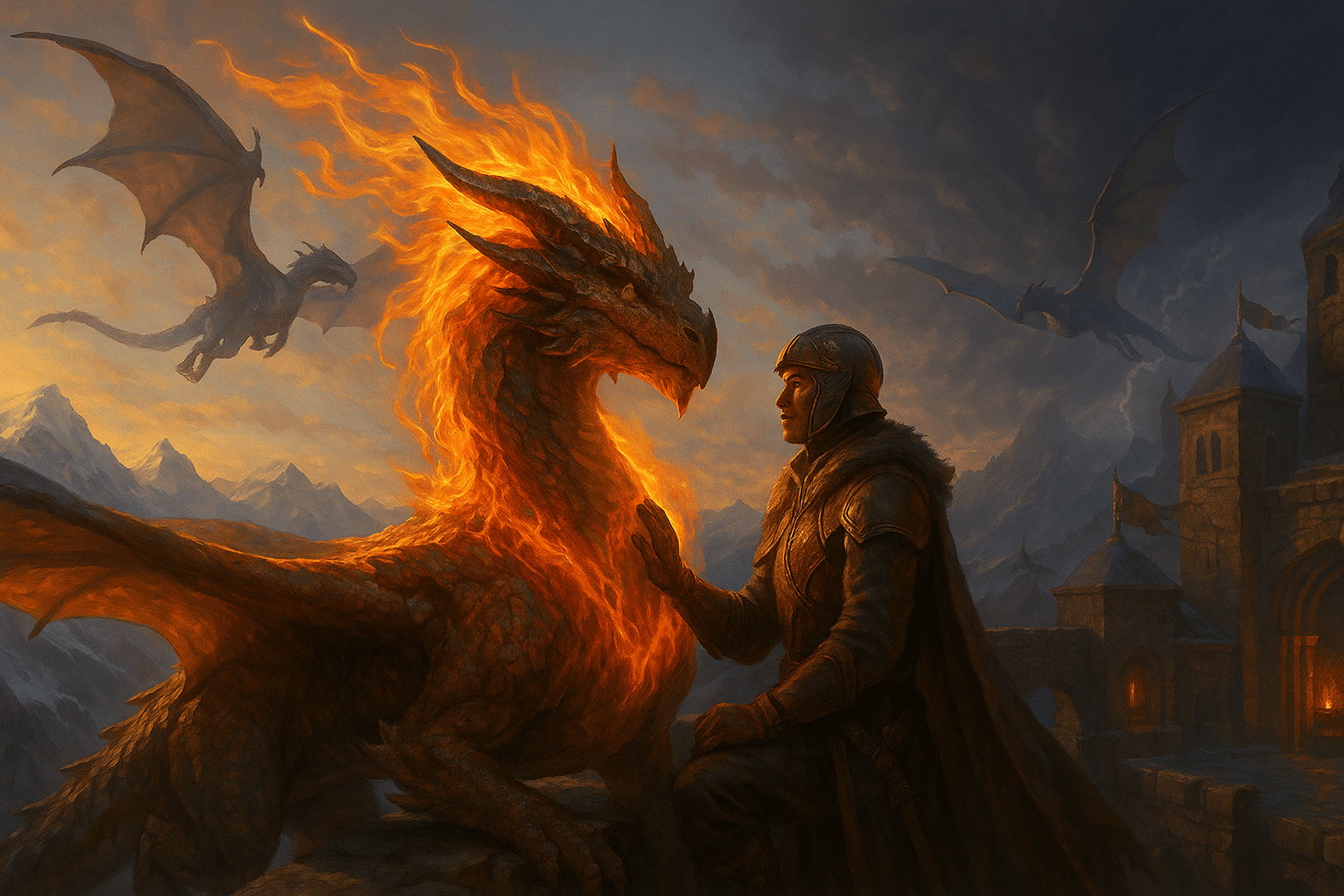Embermanes
Fire that feels you feel.

They were a rumor first—a flare seen from a high saddle, flame that bent with a rider’s breath instead of the wind. We called it trick light, wishful thinking after too many years of dwindling flights. Then a young rider named Nyra touched her palm to a bronze muzzle and the fire did not roar. It answered. Since then, the word has returned to our ledgers and our songs: Embermanes.
Ascendance.
If you scrape the soot from Itharûn’s oldest tablets, you find margins full of hearts and heat: notes on “affective resonance,” cautions in the rider catechisms about “temper tethering,” and a crest seldom painted—flames drawn as a mane. The Pact of Flame and Aether produced many lines, but most scholars agree the Embermanes were rare even then—dragons who wore a corona that brightened with their rider’s courage and dimmed with their fear. They weren’t shock troops like the Stormriders, nor steady watch as the Sky-Dragons. They were bridges—between command and compassion, might and restraint. A handful of Embermanes led quellings that ended without blood, their aura cooling mobs and calming beasts. And then, as empires reached for higher peaks, the Order lost the habit of listening more than speaking. Those notes in the margins stopped.
Fracture.
When the Shattering buckled the ridges and rattled the old bonds, such delicate pairings were the first to fail. Embermanes did not go feral so much as quiet. Some fled the keeps and laid down in hidden eyries until even their names fell to ash. Others died alongside riders who mistook panic for power—their own fear feeding the aura until it burned them both. In that age of cracked leylines and louder hungers, who had counsel for gentler fires? Itharûn clung to whatever held the walls upright: Stormriders, duty, steel. The Embermanes became a rumor of a rumor.
Twilight.
After the Last Sky War, we counted fewer dragons and more ghosts. Veterans taught that feeling was a liability; discipline alone kept you breathing. A few stubborn keepers preserved soft practices—a hand on the muzzle, a minute of shared breath before flight—but the manuals read as if written by stone. If Embermanes still lived, they hid in the mountain’s misremembered folds. Bards sometimes sang about “the flame that listens,” but only in warm taverns when the wind wasn’t angry.
Echoes.
Then the world began to answer back. As the Prism Star steadied the heavens and old oaths found new voices, excavations along the high passes uncovered a clutch—eggs engraved by heat itself, their shells veined in ember-gold. The first to hatch chose Nyra. Her dragon, Ignivar, did what no instructor had prepared her for: mirrored her. When she faltered, his fire guttered; when she steadied, it steadied; when she remembered why she had sworn the Warden’s Oath—not glory but guardianship—the flame rose around them in a mane like sunrise. Aurelion Flameheart read the omen and reopened a discipline that had been locked away since Ascendance: the Litany of Bearing.
Anatomy & temperament.
Embermanes are large, long-winged dragons whose most distinctive feature is the living corona that ripples from crown to withers and along the tail ridge. The “mane” is not hair but a sheath of particulate fire—an aura shaped by will and emotion, brightening in layers rather than in a single blaze. Their scales tend toward copper, brass, and burnished umber; their eyes hold a second iris that tightens with strong feeling rather than with light. They are loyal without being slavish, curious without being naïve, and they learn faces the way other lines learn terrain.
Gift & cost.
Their breath is less a cone than a pulse: a wave of heat that can cauterize wounds, harden shattered ramparts, or—when channeled through the rider’s poise—push an enemy line without reducing it to cinders. The same gift is a liability when anguish leads: grief thins the aura into lashing streamers; rage makes it starve the air. Training pairs feeling with craft. Riders keep journals, not for poetry but calibration: what steadied you today, what scattered you, how did the fire show it? Chaplains and smiths serve on the same teams; the former teaches bearings of the heart, the latter forges baffles and vanes that let the aura be shaped rather than merely endured.
Bonding & culture.
An Embermane chooses a rider who can carry weight without hardening around it. The bond rite is simple and unspectacular: shared quiet in a dark eyrie, a lantern hooded, a hand on a keel-bone until two breathing rhythms become one. Among the Wardens, Embermane pairs are assigned to rescue corridors, negotiations that might turn to sieges, and the first wave after alarms—where restraint buys time and time saves lives. Within the flights, Embermanes often act as emotional anchors; even Sky-Dragons ease their shoulders when a mane glows steady at the edge of vision.
Neighbors & rivals.
Galdrowen respects them, calling their aura “green fire’s cousin.” Thornspines dislike the warmth on their sensitive quill-beds but obey an Embermane’s low croon at border hand-offs. The Whispering Bloom mistrusts them profoundly; Memory Drakes report that the mane’s resonance destroys planted whispers like dry leaves. As for Thar Zûl, the Embercore’s unstable radiance agitates Embermanes into a flicker that riders must learn to damp with the Litany. Cindermaws charge at the glow as if insulted by a flame that refuses to devour.
What they mean.
Itharûn’s strength has always been more than talons and steel. The Embermanes remind us that power can be directed without being unleashed, that the hottest fire is often the one that keeps vigil rather than the one that burns. Six confirmed pairs now circle Highspire at dawn. Their manes do not roar against the sun. They greet it—and in that greeting, a tired kingdom finds its balance again.
